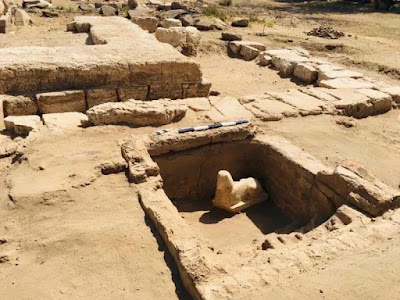The small statue was recovered from the ruins of a tomb east of the Dendera Temple.
Rhea Nayyar
The small sphinx
statue unearthed from a limestone ruin beside the Dendera Temple in Qena, Egypt
(all images via Egyptian Ministry of Tourism and Antiquities)
The Egyptian Ministry of Tourism and Antiquities has announced the discovery of a small sphinx beside the Dendera Temple in Qena, Egypt.
The Roman-era sphinx, much smaller than its monumental counterpart that famously guards the Pyramids of Giza, was found during an archaeological mission helmed by Ain Shams University professor and former Tourism and Antiquities Minister Mamdouh El-Damaty.
The small limestone statue was recovered from the ruins of a tomb east of the Dendera Temple. Dating back to the first century, the sphinx’s face resembles that of Roman Emperor Claudius due to a similarity in forehead structures beneath the Nemes headdress.
The Roman-era sphinx found in a Byzantine-era
basin
However, while the Roman Empire had control over the Nile river and surrounding areas during Claudius’s reign from 41 to 54 CE, the emperor reportedly never visited North Africa during his lifetime.
Some experts that weren’t affiliated with the archaeological mission have stated that the images presented by the ministry are too small for them to determine if the limestone sphinx could be a representation of the emperor.
Live Science
also noted that the platform and water collection basin that the sphinx was
found near dated to the Byzantine era, 500 years past Claudius’s reign.
El-Damaty described the statue as “wonderfully
beautiful” for its accurately represented royal features and remnants of red
and yellow paints that still mark the face. A Roman-era stone slab with
hieroglyphics and demotics (an Ancient Egyptian script) was found beneath the
statue, but no translations have been made yet.
The Tourism and Antiquities Ministry confirmed
that further excavation work around the sphinx’s discovery site would be taking
place alongside a project at the front of the Isis Gate to uncover a road that
links the two. The agency has not yet responded to Hyperallergic‘s request for
comment.
https://hyperallergic.com/806725/mini-roman-era-sphinx-discovered-near-egyptian-temple/
AND, CHRISTIE´S
 |
| ‘At the heart of the whirlpool’ — were Vorticists the most avant-garde artists Britain has known? |


No hay comentarios:
Publicar un comentario